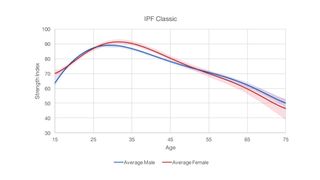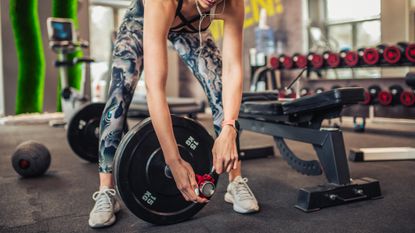Just as the cringe-worthy new year, new me posts begin to appear on your IG feed, you might start considering the possibility to do something about the flab that surrounds your torso, too. It's time to tone up and build muscle! But you're not in your 20s anymore, and we all know that strength decreases over age; there is no point in starting weight training now. Or is there?
When visualising how strength works, most people imagine an upward line that falls of a cliff as soon as you hit 30. Like, straight down. After 30, you might as well steer clear of barbells and dumbbells; they aren't any good for you! Kettlebells are for teenagers, not seniors like you, celebrating your 35th birthday next November.
What if we told you there is a chart that proves that building muscle and strength at any age is not only possible but recommended? That you can start lifting at the young age of 55 and be the strongest you've ever been five years later? That there is no reason why you shouldn't be lifting adjustable dumbbells right now?

Have a look at the chart above. It's from Strongur, and it collates data from thousands of IPF lifters, where IPF stands for International Powerlifting Federation. Powerlifters, unlike bodybuilders, train for strength and not for muscle size (powerlifters tend to be very big, too, but differently) so they are a good indicator of just how strong people can be at any age, should they train hard.
They are also highly motivated, have ample training experience and compete by doing only three exercises – deadlift, squat and bench press – making it all the easier to compare performance data from powerlifters.
At first glance, it shows what we all expected: as you get older, you lose strength. IPF athletes are the strongest in their mid-to-late twenties. From there onwards, strength decreases in both men and women.
However, this decrease is gradual and happens over a long period of time. As you can clearly see, the strength index of a 45-year-old is only 10 points under the strength index of a 25-year-old male lifter. Women are in an even better position; most female IPF athletes seem to peak later than men, and the drop in strength also happens later and more gradually.
How strong are you, really?
Many factors play into how strong you are at any point in your life, including testosterone levels (find out what testosterone is and how it affects you), stress, physical activity levels and so on. Saying that you will be as strong as an IPF athlete in their 40s and 50s is also a bit of a stretch.
However, you can probably be way stronger than you are right now in a couple of years if only you started lifting. Even if the first time you ever visited a gym happened when you were 50, should you carry on working out from then on, you'll be stronger than ever by your 55th birthday. Easy as that.
It's all about consistency and showing up in the gym, week after week, month after month. You'll see results soon enough, but the real benefit of lifting is the fact that your muscles and joints will get stronger and your body will become more resilient. You will be able to fall and not break bones and pick up boxes with ease.
Don't fancy signing up for a gym membership? Building a home gym in 2022 is not a radical idea either. All you need is a few free weights and a decent weight bench. Don't let age prevent you from building muscle and losing weight; you can get fit over 40!



